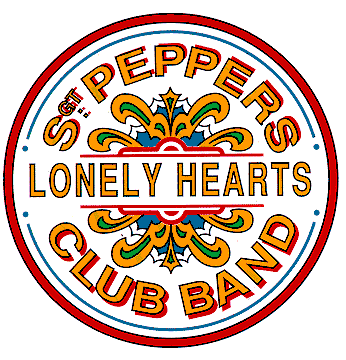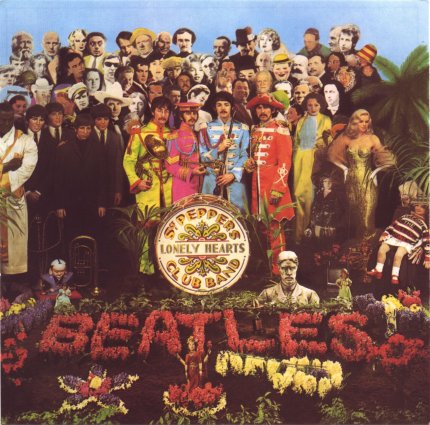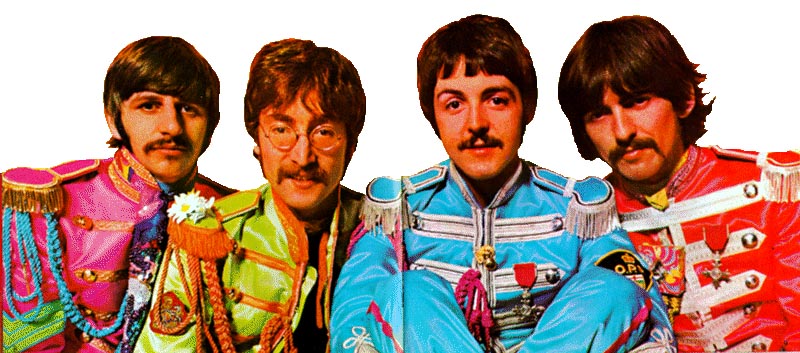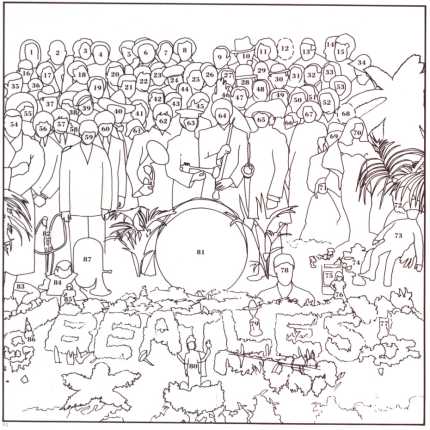
Album and Recording Information
![]()


Who are they?
Recording Information: Liner notes from Limited Woodbox Ed. -
written by Mark Lewisohn. Mark Lewisohn is also the author of The Beatles Live! and The
Beatles: 25 Years In The Life.
The recording of Sgt Pepper's Lonely Hearts Club Band spanned 129 days, perhaps the most creative 129 days in the history of rock music. Here is a guide to the way the album was made.
The title track of this epochal album, 'Sgt Pepper's Lonely Hearts Club Band' was a fine Paul McCartney song utilizing - in addition to the usual Beatles instrumental line-up - four French horn players (overdubbed on 3 March 1967), various sound effects including those of a band warming-up and audience applause and laughter from the Beyond The Fringe stage recording, and a terrific McCartney lead vocal. The song inspired the concept of the album, not the other way, around, so until this recording commenced on I February 1967 the two previously taped album songs had not shared any deliberate, connecting thread. Recording commenced in studio two at Abbey Road on February 1 1967. Album version mixed from take ten. Writer: Paul. Lead vocal: Paul. Producer: George Martin. Recording engineer: Geoff Emerick. Second engineer: Richard Lush.
Written by John and Paul expressly for Ringo, this song was one of the final Sgt Pepper's Lonely Hearts Club Band recordings,commenced on 29 March 1967 with the briefly adopted working title 'Bad Finger Boogie'. The song is segued to its LP predecessor by more sound effects, including screaming Beatles fans from the group's Hollywood Bowl concert recordings! The song was completed the next day in a late night session after the Beatles had spent the evening shooting the photographs for the sleeve of the album.'With A Little Help From My Friends' has twice been taken to number one on the British singles chart: by Joe Cocker in 1968 and by Wet ,Wet, Wet in 1988. Clearly then, a special song. Recording commenced in studio two at Abbey Road on March 29 1967. Album version mixed from take 11. Writers: John and Paul. Lead vocal: Ringo. Producer: George Martin. Recording engineer: Geoff Emerick. Second engineer: Richard Lush.
Inspired by a painting by his almost four-year-old son Julian, who gave his work of art the same title, 'Lucy In The Sky With Diamonds' swiftly evolved into a kind of Lennon musical vision of Alice In Wonderland. The basic track, overdubs and mixing were all effected at different speeds giving the song an ethereal quality in keeping with the imaginative lyrics. Recording commenced in studio two at Abbey Road on March 1 1967. Album version mixed from take eight. Writer: John. Lead vocal: John. Producer: George Martin. Recording engineer: Geoff Emerick. Second engineer: Richard Lush.
A fine Paul McCartney song, with a little lyrical help from John Lennon. Like Lucy In The Sky with Diamonds', the recording includes a tamboura played by George Harrison. Recording commenced in studio two at Abbey Road on March 9 1967. Album version mixed from take 15. Writer: Paul. Lead vocal: Paul. Producer: George Martin.
The recording of 'Fixing A Hole' took place at two different studios, London Independent Regent Sound and the Beatles' customary EMI venue in Abbey Road. It was the group's first British session for EMI outside of Abbey Road, although this was to prove a more regular practice thereafter. Recording commenced at Regent Sound Studio, Tottenham Court Road, London, on February 21 1967 and later completed at Abbey Road. Album version mixed from take three. Writer: Paul. Lead vocal: Paul.
The great ballad on Sgt Pepper's Lonely Hearts Club Band, again written by Paul. There is no Beatles instrumentation on this recording, just ten outside musicians recruited to play violins, violas, cellos, double-bass and a harp, and apart from Paul's lead vocal the only other Beatle present is John, who joins Paul for occasional backing. The musical score was arranged not by George Martin (who did nonetheless conduct the recording) but by Mike Leander, five years before his memorable teaming with Gary Glitter. Recording commenced in studio two at Abbey Road on March 17 1967. Album version mixed from take nine. Writer: Paul with John. Lead vocal: Paul. Producer: George Martin.
A fine Lennon song which benefits greatly from a superbly atmospheric studio recording and the simple innovation of chopped up and randomly reassembled recording tape. The lyric is derived almost entirely from an antique poster advertising a circus which took place at the Town Meadows, Rochdale, on Tuesday 14 February 1843. Recording commenced in studio two at Abbey Road on February 17 1967. Album version mixed from take nine. Writer: John. Lead vocal: John. Producer: George Martin.
A moving, philosophical song written by George Harrison, his only composition on the album. The second of his two Indian music Beatles recordings, it features session musicians recruited from the Asian Music Circle in north London, more Indian instruments played by George and the Beatles' assistant Neil Aspinall, eight violins, three cellos, a little acoustic guitar and a great Harrison vocal. No other Beatles participated and 'Within You Without You' was the album's last song to be completed. Recording commenced in studio two at Abbey Road on March 22 1967. Album version mixed from take two. Writer: George. Lead vocal: George. Producer: George Martin.
The first album track to be completed, 'When I'm Sixty Four' was wrapped up ten days before the end of 1966. The song had been written by Paul some years previously - the Beatles had performed it acoustically in the Cavern Club when their amplifiers broke down; now newly revived and suitably polished, recordings began on 6 December 1966, while 'Strawberry Fields Forever' was on the boil and before 'Penny Lane' was begun. (See Magical Mystery Tour.) Three clarinetists were brought in on 21 December to augment the Beatles' own instrumentation, then - like 'Lucy in The Sky With Diamonds' - the song was speeded up quite considerably during remixing. Recording commenced in studio two at Abbey Road on December 6 1966. Album version mixed from take four. Writer: Paul. Lead vocal: Paul. Producer: George Martin.
Paul's ode to London's female traffic wardens, first recorded on 23 February 1967 and completed with an overdub of honky-tonk piano played by George Martin on 21 March. Considerable tape echo in their headphones encouraged the Beatles to add moans, sighs, screams and the sound of a comb and toilet paper at the end of the song. Recording commenced in studio two at Abbey Road on February 23 1967. Album version mixed from take 11. Writer: Paul. Lead vocal: Paul. Producer: George Martin.
A John Lennon song initially inspired by a television commercial for cornflakes which then drifts into an everyday story about everyday, complete with a reference to the British TV comedy show Meet The Wife. The song includes a brass overdub by six musicians from Sounds Inc, rock music's very own big band, managed by Brian Epstein, and it ends with a succession of carefully compiled animal sound effects from the EMI collection, added to the song, to Lennon's specification, in an order whereby each successive animal is capable of frightening or devouring its predecessor. Recording commenced in studio two at Abbey Road on February 8 1967. Album version mixed from take 11. Writer: John. Lead vocal: John. Producer: George Martin.
The quickest and technically simplest song on the album, this reprised and abbreviated remake of Paul's album title track was recorded from start to finish in just one session on Sunday I April 1967, with all four Beatles sharing the lead vocal. Two days later, Paul flew out to the USA leaving only the completion of George's 'Within You Without You' and the final mixing to be done. Recording commenced in studio one at Abbey Road on April 1 1967. Album version mixed from take nine. Writer: Paul. Lead vocal: John, Paul and George. Producer: George Martin.
A momentous recording in every way, melding riveting Lennon lyrics and a contrasting yet perfectly applicable verse penned by Paul McCartney to two superb and effective orchestral buildups and a seemingly everlasting coda - the long, long crashing piano and harmonium chord which slowly evaporates into silence and the end of the album. The recording began as 'In The Life Of. . . 'on 19 January, just two days after the appearance of an item in the Daily Mail newspaper which inspired part of John's lyric. The massive orchestral crescendos were recorded by 40 musicians on 10 February, conducted by Paul McCartney, and they were taped four times over, thus sounding like 160 musicians. The piano/harmonium coda was recorded on 22 February after the Beatles' initial idea of humming the final chord had proved ineffective. Recording commenced in studio two at Abbey Road on January 19 1967. Album version mixed from takes six and seven. Writers: John, with Paul. Lead vocal: John, with Paul. Producer: George Martin.
Three other songs were recorded during the sessions. The first two were taken for release as a single, the third didn't surface until the Yellow Submarine film soundtrack album. 'Strawberry Fields Forever'. Recording commenced in studio two at Abbey Road on November 24 1966. 'Penny Lane'. Recording commenced in studio two at Abbey Road on December 29 1966. 'It's Only a Northern Song'. Recording commenced in studio two at Abbey Road on February 13 1967.
The sequence of songs on Pepper is famous in itself, being - on the vinyl version - two continuous sides of music, without pauses between songs, or 'banding', to use recording parlance. But the line-up of side one, as first conceived, was different to how it finally evolved, and was as follows: 'Sgt. Pepper's Lonely Hearts Club Band'; 'With a Little Help From My Friends'; 'Being for the Benefit of Mr Kite!'; 'Fixing a Hole'; 'Lucy in the Sky with Diamonds'; 'Getting Better'; 'She's Leaving Home'.
The Cover
I asked them to make lists of people they would like to have in the audience at this imaginary concert. John's was interesting because it included Jesus and Ghandi and more cynically, Hitler. But this was just a few months after the U.S. furor about his 'Jesus' statement, so they were left out. George's list were all gurus. Ringo said "What ever the others say is fine by me", because he didn't really want to be bothered. Robert Fraser and I also made lists. We then got all the photographs together and had life-size cut-outs made onto hardboard.
EMI realized that because many of the people we were depicting were still alive, we might be sued for not seeking their permission. So the Beatles manager, Brian Epstein, who was very wary of the complications in the first place, had his assistant write to everyone. Mae West replied "No, I won't be on it. What would I be doing in a lonely hearts club?" So the Beatles wrote her a personal letter and she changed her mind.
Robert Fraser was a business partner of Michael Cooper, an excellent photographer, so he was commissioned to do the shoot. I worked in his studio for a fortnight constructing the collage, fixing the top row to the back wall and putting the next about six inches in front and so on, so that we got a tiered effect. Then we put in the palm tree and the other little objects. I wanted to have the waxworks of the Beatles because I thought they might be looking a Sgt. Pepper's band too. The boy who delivered the floral display asked if he could contribute by making a guitar out of hyacinths, and the little girl wearing the "Welcome the Rolling Stones, Good Guys" sweatshirt was a cloth figure of Shirley Temple, the shirt coming from Michael Cooper's young son, Adam.
The Beatles arrived during the evening of March 30. We had a drink, they got dressed and we did the session. It took about three hours in all, including the shots for the center-fold and back cover.
Who are they Click on image for their names. (A person with lots of time would have made a nice image map here)
The very distinctive Sgt. Pepper's cover has been copied several times. See Beatletracks for a nice treatment of this topic.
![]()